KFF Health Tracking Poll – Late April 2020: Coronavirus, Social Distancing, and Contact Tracing
Social Distancing And Contact Tracing
Key Findings:
- The latest KFF Health Tracking Poll conducted April 15-20th finds about half the public (51%) now saying that when it comes to the coronavirus outbreak in the U.S., “the worst is yet to come.” This is down 23 percentage points from the share who said the same (74%) in the Early April KFF Health Tracking Poll conducted less than three weeks ago. Majorities of Democrats (64%) and independents (56%) continue to say “the worst is yet to come,” but now twice as many Republicans say “the worst is behind us” (53%) as say “the worst is yet to come” (27%).
- While an increasing share of the public now say the worst of the outbreak is behind us, most Americans (80%) say strict shelter-in-place measures are worth it in order to protect people and limit the spread of coronavirus. Fewer (19%) say the strict shelter-in-place measures are placing unnecessary burdens on people and the economy and causing more harm than good. Majorities also say they can continue following strict social distancing and shelter-in-place guidelines for more than another month while less than one in five say they either cannot follow the guidelines at all (3%) or say they can follow the guidelines for less than a month (14%). While a majority of Republicans say they can follow social distancing guidelines for a month or longer, three in ten Republicans say they can either follow them “less than one month” or “not at all.”
- The severity of an outbreak in one’s area appears to be related to behaviors around visiting friends and family outside the home. Among those living in counties with 5 or fewer COVID-19 deaths, 36% say they have left their home at least once in the last week to visit with friends or family, compared with 21% of those living in counties with more than 25 deaths.
- The vast majority of adults (84%) say their lives have been disrupted at least some by the coronavirus outbreak in the U.S. This is up 12 percentage points from the KFF Health Tracking Poll conducted March 25-30 and up 44 percentage points from the March 11-15 poll.
- While the public is divided in their willingness to download apps for their phones as a way to trace and monitor the contacts of people infected with coronavirus, support increases to as high as 66% once people hear the argument that this could allow for many schools and businesses to reopen. Republicans are less willing to download and use a contact tracing app than Democrats and independents.
Over the past two months, the coronavirus outbreak has drastically changed the way of life in the U.S. With nearly 800,000 reported cases of the novel coronavirus in the U.S. and more than 42,000 reported deaths, many in the country are wondering when, if ever, normal life will return. When coronavirus led to the closing of schools and businesses in early March, the KFF March Tracking Poll found four in ten adults already reporting that their lives had been disrupted either “a lot” or “some” as a result of the virus. Now, five weeks later, the latest KFF Health Tracking Poll finds the share who say their life has been disrupted has more than doubled to 84%. This includes large majorities across race and ethnicity, gender, and parental status.

At least eight in ten Republicans (82%), independents (81%), and Democrats (89%) now say their lives have been disrupted. This is more than a 50 percentage point increase from the far smaller share of Republicans (30%) who initially reported disruption back in early March, and a larger share of both independents (up 41 percentage points) and Democrat (up 40 percentage points) also now report their lives have been disrupted at least some by coronavirus.
Partisans Differ On U.S. Future Outlook and Support For Shelter-In-Place Measures
While the partisan divide on whether their lives have been disrupted by coronavirus has largely dissipated, there are now substantial partisan differences in people’s outlook on how coronavirus will impact the U.S. in the coming months.
In late March, a majority of the public said that when it came to the coronavirus outbreak in the U.S., “the worst was yet to come” (74%), while few (13%) said the “worst is behind us.” This included majorities of Democrats (82%), independents (77%), and Republicans (66%) saying “the worst is yet to come.” The latest KFF Tracking Poll now finds about half of the public (51%) saying the “worst is yet to come,” down 23 percentage points in less than three weeks. Majorities of Democrats (64%) and independents (56%) continue to say the “worst is yet to come,” but now one-fourth (27%) of Republicans say “the worst is yet to come” (down 39 percentage points from the March 25-30 KFF Poll). A slight majority (53%) of Republicans say “the worst is behind us,” while far fewer, but still twice as many who said this less than three weeks ago, independents (31%) and Democrats (21%) now say the same.
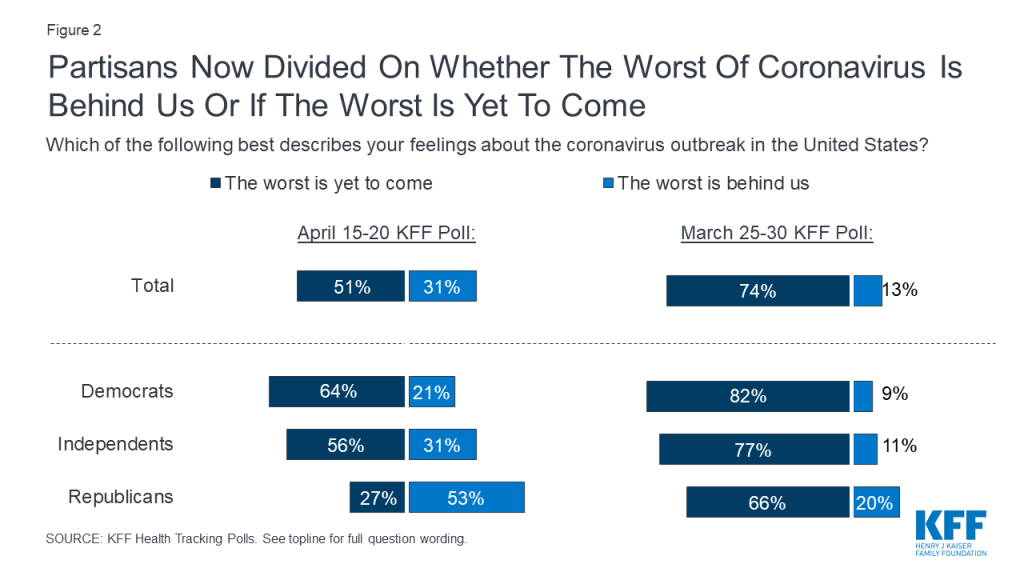
This partisan divide may reflect the mixed messages from governors, President Trump, and public health officials. While public health officials are warning about the possible impacts of relaxing social distancing measures, three Republican governors announced this week that some non-essential businesses will be allowed to re-open.
Despite this, a large majority of adults (80%) say strict shelter-in-place measures are worth it in order to protect people and limit the spread of coronavirus. Fewer (19%) say the strict shelter-in-place measures are placing unnecessary burdens on people and the economy and causing more harm than good. While majorities across partisans say these measures are worth it, a larger share of Republicans (38%) compared with independents (16%) and Democrats (5%) say they are causing more harm than good.
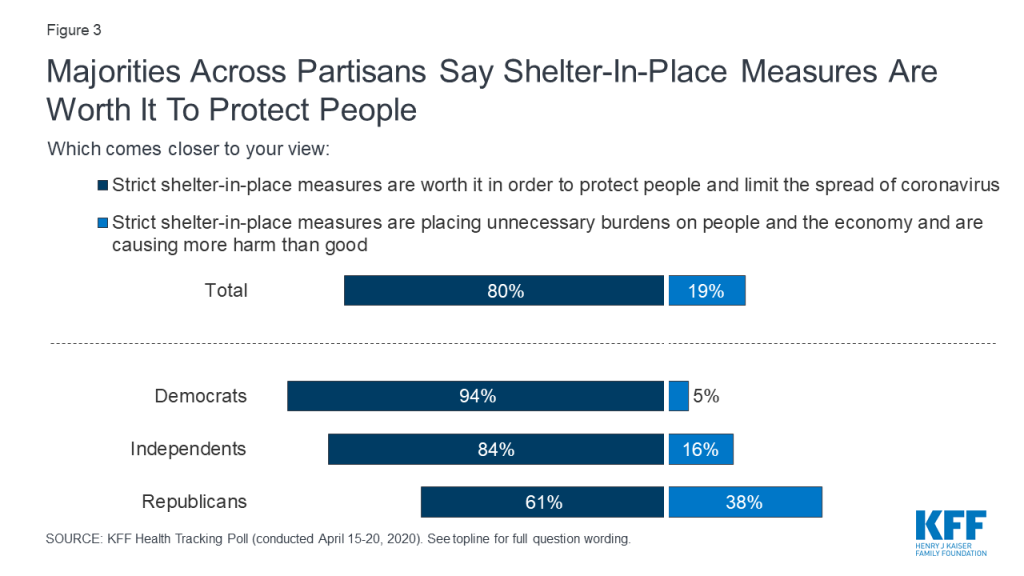
Some Republican governors have been among the strongest voices for re-opening businesses and lifting strict shelter-in-place orders sooner rather than later. However, even among Republicans living in states with Republican governors, a larger share say the strict measures are worth it (63%) than say they are causing more harm than good (36%).
| Table 1: Majorities Across Partisans Living In Republican-Led State Support Strict Shelter-in-place Measures | ||||
| Which comes closest to your view? | Living in a state with a Republican Governor | |||
| Total | Democrats | Independents | Republicans | |
| Strict shelter-in-place measures are worth it in order to protect people and limit the spread of coronavirus | 79% | 96% | 83% | 63% |
| Strict shelter-in-place measures are placing unnecessary burdens on people and the economy and are causing more harm than good | 20 | 4 | 16 | 36 |
Social Distancing and Sheltering-in-Place
Residents in most parts of the U.S. have been engaging in social distancing or sheltering-in-place for several weeks and all states, including Washington D.C., have issued mandates either restricting businesses, travel, or the activities of their residents. To see a complete list, see State Data and Policy Actions to Address Coronavirus.
Most adults (84%) say they have been sheltering-in-place because of the coronavirus outbreak and only leaving their home for essential services such as food, medicine, and health care – a similar share who reported this in the KFF Early April Tracking Poll (82%). Three-fourth of adults (76%) say they have bought or made a protective mask to wear in public, consistent with many social distancing guidelines issued by states. Those living in counties where more than 25 people have died from COVID-19 are more likely than those in counties with 5 or fewer deaths to report using a mask (82% vs. 69%).1
On April 16th President Trump announced guidelines for states to begin lifting shelter-in-place and social distancing restrictions in order to reopen businesses and get the economy going again2 but many states have announced that it could be weeks or even months until many shelter-in-place restrictions are lifted. With all of this uncertainty, the majority of Americans say they can continue following strict social distancing and shelter-in-place guidelines in order to limit the spread of coronavirus in their communities.
Eight in ten say they can follow strict social distancing and shelter-in-place guidelines for more than another month, including 37% who say they can follow the guidelines between 1 and 3 months, and one in ten who say they can follow them between 4 and 6 months. An additional one-third (34%) say they can follow them for more than 6 months longer, indicating there is a group of Americans who are willing to follow the guidelines as long as it takes to limit the spread of coronavirus.
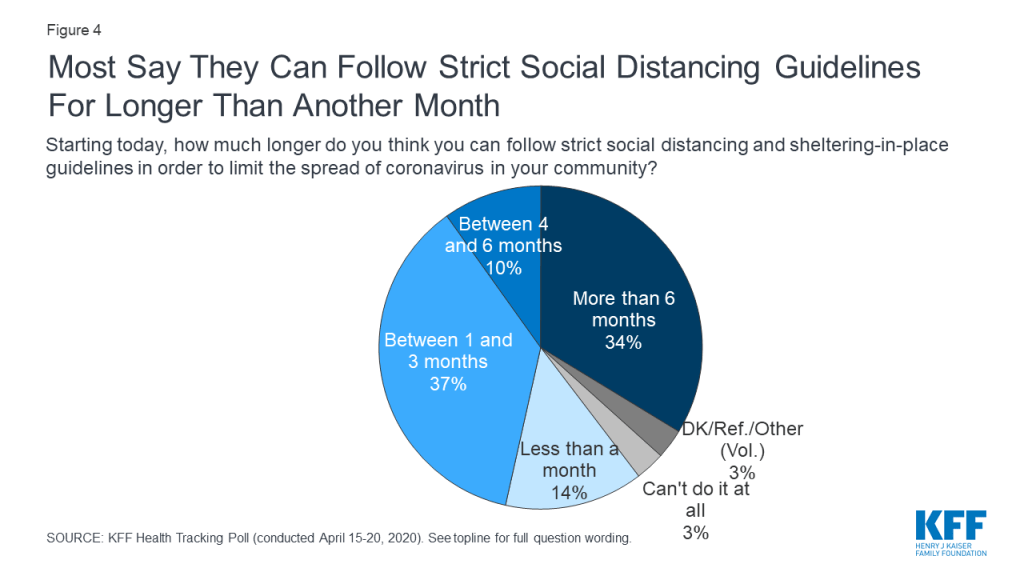
On the other hand, there is a segment of the population who either isn’t willing to social distance for much longer or even at all. Nearly one-fifth say they can follow these strict guidelines for less than a month (14%) or say they are not willing to do it any longer (3%).
Majorities of Democrats (92%), independents (80%), and Republicans (68%) all say they can follow strict social distancing and sheltering-in-place guidelines for a month or longer, though Republicans are less likely than others to say they can sustain this practice for more than three months (31% compared to half of Democrats and 44% of independents).Three in ten Republicans say they can only follow strict social distancing and sheltering-in-place guidelines for less than another month (compared to seven percent of Democrats and 17% of independents).
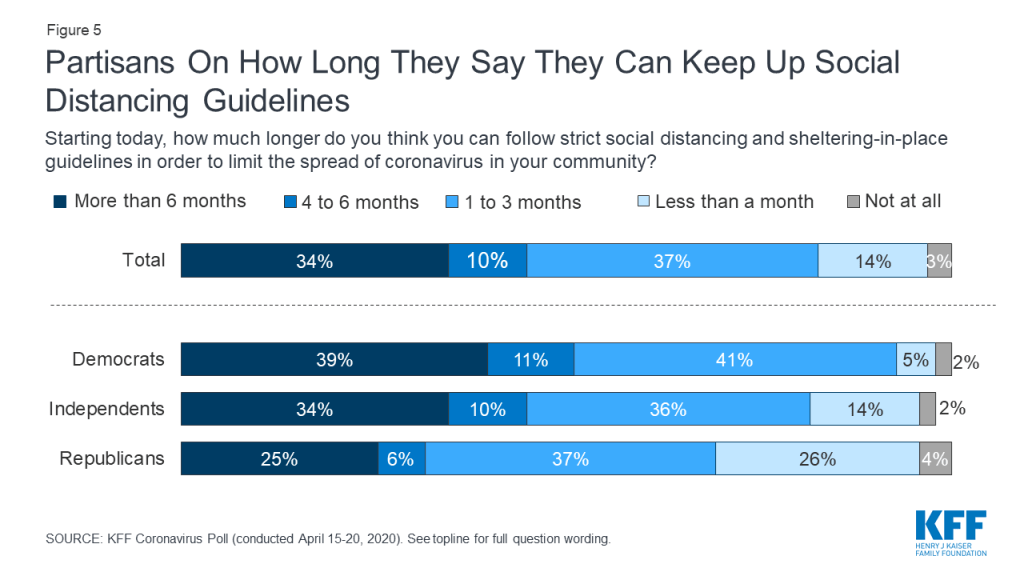
With all states issuing either shelter-in-place or some social distancing restrictions (i.e., restricting the size of gatherings or closing schools), the majority of adults say they have not left their home at all during the last week either to visit close friends or family (70%), go to work (67%), or exercise (57%). About one in five (20%) say they haven’t left their home to shop for food, medicine, or essential household items but an additional 36% say they have only left their home once to do this.
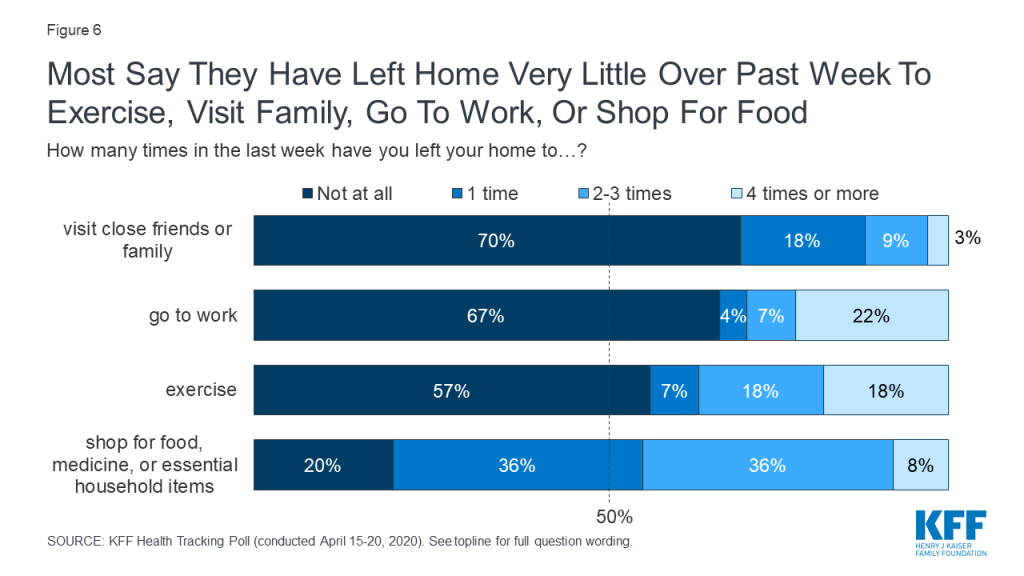
A small share (10%) of adults say they have left their home 4 or more times in the past week to either shop for food, medicine, or essential household items, or to visit close friends and family – activities that all leaders are encouraging people, even those who are essential workers, not to engage in or at least not often. This includes 7% of adults 60 and older who either have a chronic condition themselves or lives in a household with someone who has one, a group most at-risk for complications of coronavirus, who say they have left their home 4 or more times.
The severity of an outbreak in one’s area appears to be related to behaviors around visiting friends and family outside the home. Among those living in counties with 5 or fewer COVID-19 deaths, 36% say they have left their home at least once in the last week to visit with friends or family, compared with 21% of those living in counties with more than 25 deaths.
Essential Workers
While one-fifth of Americans say they have left their home 4 or more times in the past week in order to go to work, this is largely driven by those who have been deemed “an essential worker.” One-third (34%) of all adults say they have been deemed an “essential worker,” meaning they are still required to work outside their home during the coronavirus outbreak in the U.S. Three in ten adults earning less than $40,000 annually say they are essential workers compared to about four in ten of those earning between $40,000 and $89,999 (41%) or $90,000 or more annually (36%). A substantial share of essential workers (39%) say they or someone in their household has a serious health condition that could put them at higher risk of complications from COVID-19 and 13% of essential workers are over the age of 60.
Overall, most adults give themselves and the people in their household either an “A, excellent” for following the social distancing guidelines in their area over the past two weeks (53% and 52%, respectively) or a “B, good” (37% and 31%, respectively). A smaller share, but still a majority, give their neighbors or people who live near them either an “A” (35%) or a “B” (35%).
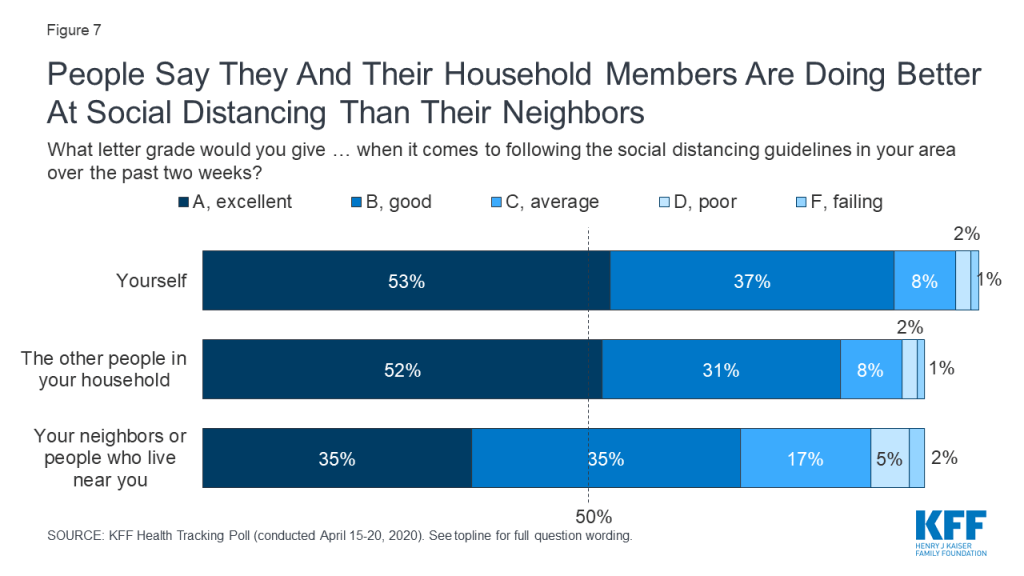
Contact Tracing and Testing
One of the key elements in any plan to reopen businesses and restart the U.S. economy is widespread contact tracing, which is the ability to trace and monitor the contacts of infected people.3 One way to track the spread of coronavirus in communities is through people’s smart phones. Using smart phones for contact tracing is being widely discussed by public health officials and experts The latest KFF Health Tracking Poll finds the public divided on whether they would be willing to download an app for these purposes, but support increases once people hear the argument that this could help allow for many aspects of daily life to resume. Yet, the public is largely skeptical of the role of tech companies in managing this data and would like to see the data controlled by public health agencies.
Overall, a majority of the public (68%), are willing to use an app on their phone to share results from a coronavirus test in order to allow public health officials to track the spread of the outbreak. Majorities across age groups and party identification, say they are willing to use an app for these purposes.
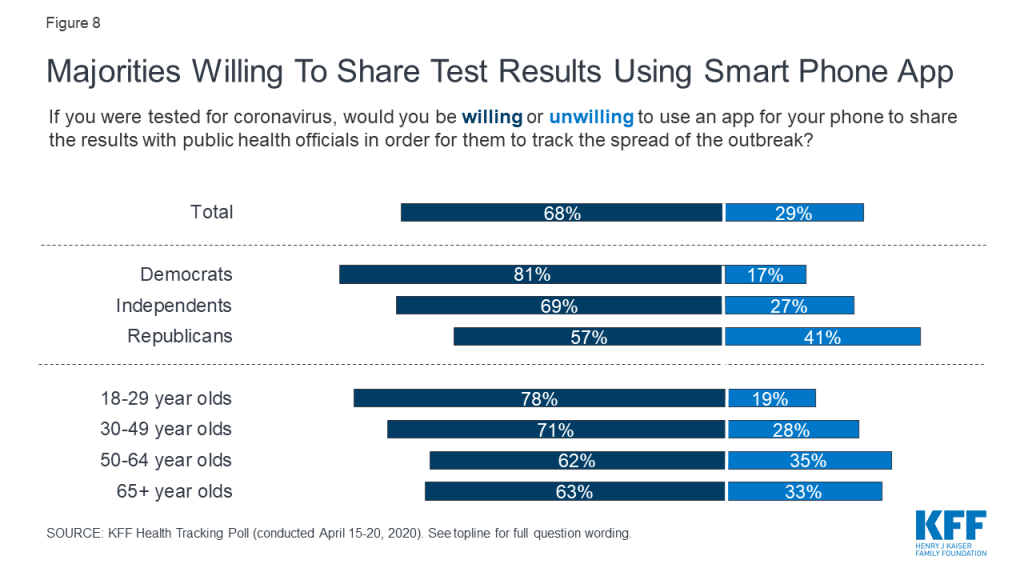
The public is more divided in their willingness to download an app for their phone that uses Bluetooth and GPS technology to track who they come into close contact with. Half of the public are “willing” to download an app that alerts them if they have come in contact with someone who has tested positive for coronavirus so that they can take steps to protect them and their family while a similar share (47%) say they are “unwilling” to download such an app. The public are somewhat more “unwilling” than “willing” to download the app if they are told the app would provide information to public health officials in order to track the spread of coronavirus (53% who say they are “unwilling” to download the app compared to 45% who are “willing”).
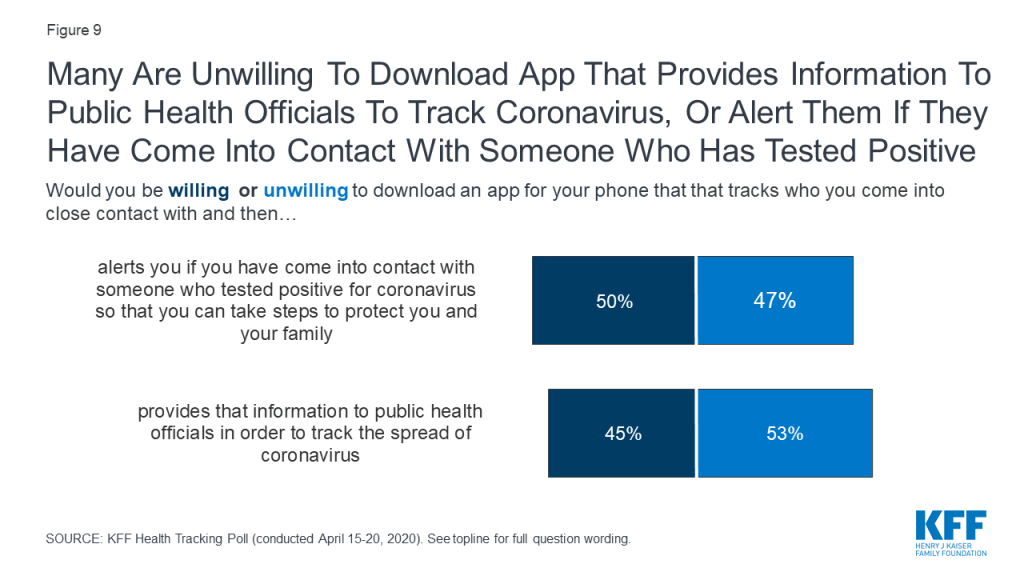
There are large differences across age groups and partisans in willingness to download contact tracing apps. While slightly more than half of 18-29 year olds saying they are willing to download an app that provides information to public health officials (53%) or alerts them if they have come into contact with someone who has tested positive for coronavirus (55%), smaller shares of older adults (65 and older) say they are willing to download an app for either of these purposes (36% and 42%, respectively).
Additionally, while about one-third of Republicans saying they are “willing” to download an app to help public health officials track the spread of the outbreak (29%) or alerts them if they have come into contact with someone who tested positive for coronavirus (35%), majorities of Democrats say they are “willing” to download an app for any of the mentioned contact tracing purposes (63% and 58%, respectively).
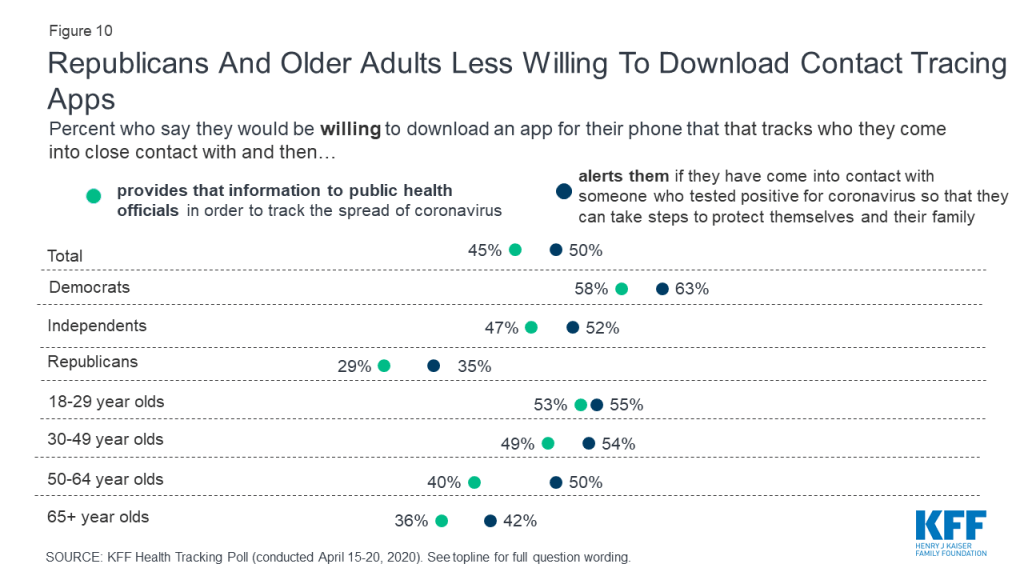
Some attitudes Change After Hearing Messages About Contact Tracing Apps
While initially divided on whether they would download an app for contact tracing, some may be willing to download the app once they hear that it would allow for many aspects of daily life to get back to normal. Two-thirds are willing to download and use the app once they hear that using such an app could allow more people to go back to work or school (66%) or that it would allow many businesses to re-open and start up the economy (66%). A smaller share, but still a majority, are willing to download the app once they hear that the app would give them information so they can talk to their doctor about what to do if they come into close contact with someone who has tested positive for coronavirus (62%) or that the data collection is “opt-in,” meaning people would have to actively choose to share the information (54%). About half (52%) are willing to download the app if the data collection is “opt-out,” meaning people would have to actively choose not to share information. Fewer are willing to download the app if they hear that they may get many alerts about being exposed to coronavirus, even if the exposure was only minor or the data could be potentially inaccurate (42%) or that there is a chance that data from the app could be hacked (28%).
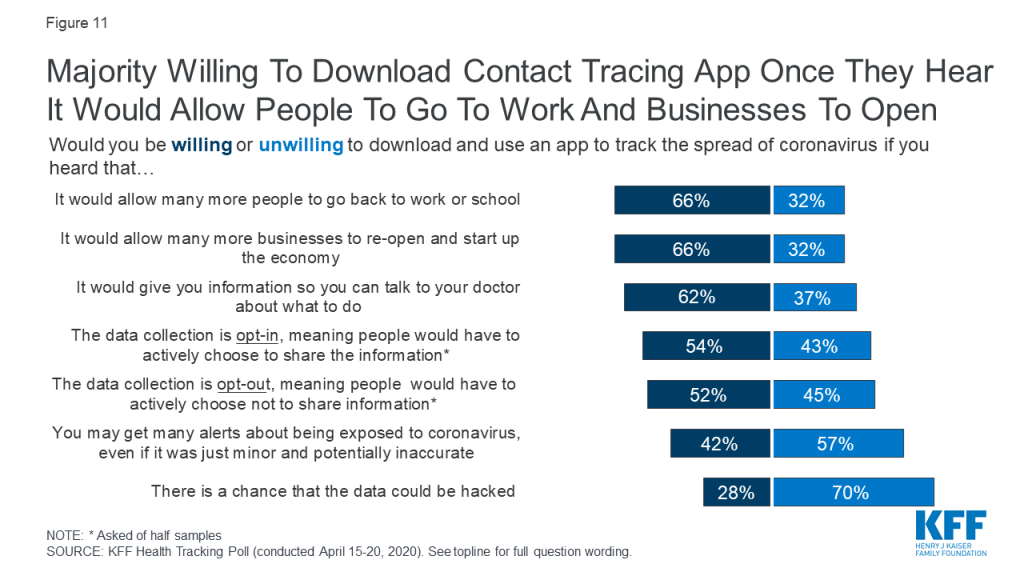
Who manages the data also affects peoples’ willingness to download an app for contact tracing. Six in ten saying they are “willing” to download an app to track the spread of coronavirus if data from the app was managed by their state health department (63%), the federal Centers for Disease Control and Prevention (62%), or their local health department (62%). Far fewer (31%) are willing to download the app if the data was managed by a private tech company.
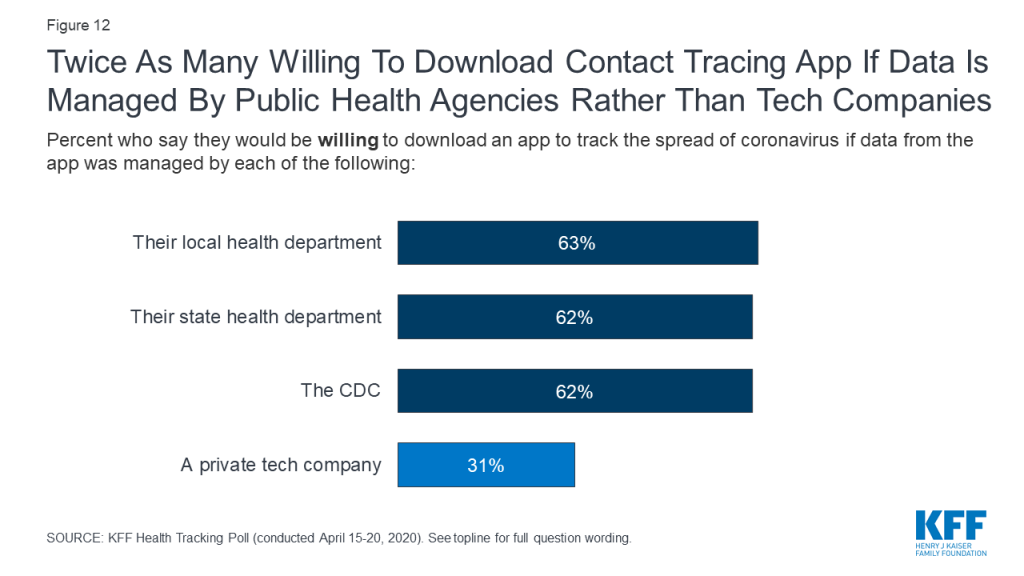
While majorities of Democrats and independents and about half of Republicans are willing to download a contract tracing app if the data was managed by the CDC or their state or local health department, fewer than four in ten Democrats (37%), one-third of independents, and one-fourth of Republicans say they are willing to download such an app if the data was managed by a private tech company.
| Table 2: Who Partisans Trust To Manage Data From Contact Tracing Apps | |||
| Percent who say they would be willing to download an app to track the spread of coronavirus if data from the app was managed by: | Party ID | ||
| Democrats | Independents | Republicans | |
| Their state health department | 80% | 64% | 46% |
| The federal Centers for Disease Control and Prevention (CDC) | 75 | 64 | 47 |
| Their local health department | 78 | 63 | 48 |
| A private tech company | 37 | 33 | 26 |
This may be due to the fact that nearly four in ten (38%) say they are more worried private companies will sell their personal data from the app while one-third (33%) say they are more worried the federal government will use the data for purposes beyond tracking the spread of coronavirus. About one-fourth (22%) volunteer that they are equally worried about both of these things.
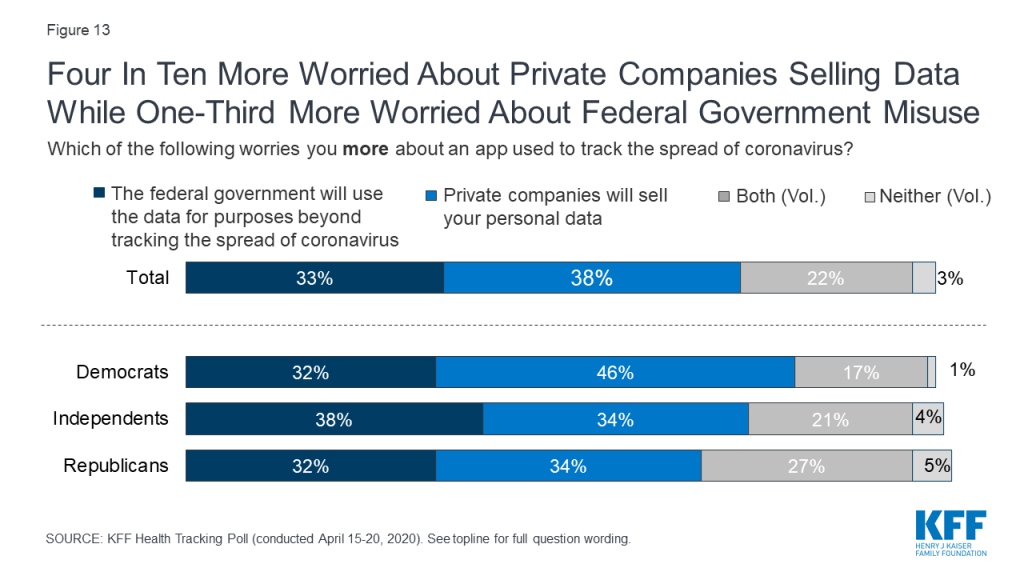
Nearly two-thirds of the public say the use of contact tracing apps either wouldn’t have any impact on how safe they feel or say they would make them feel less safe. Half of the public (47%) say having public health officials track the spread of coronavirus using apps on people’s cell phones would have “no impact on how safe they feel,” while one-third (35%) say it would make them feel “safer” and one in five (17%) say it would make them feel “less safe.”
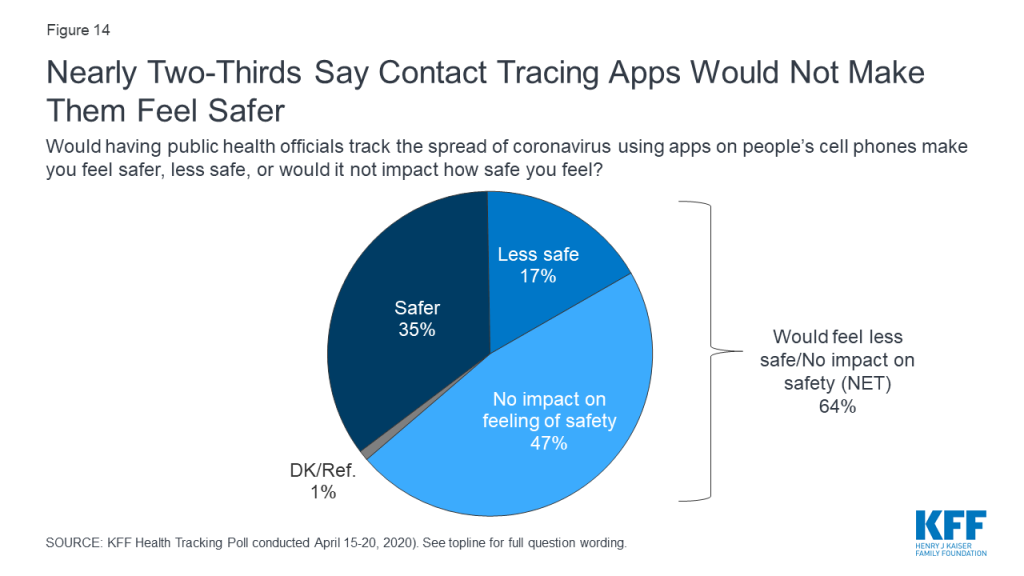
At-Home Testing
There has been discussion about the developments of a potential at-home testing kit for coronavirus with possible public availability. Seven in ten (72%) say they are either “very likely” or “somewhat likely” to use a coronavirus testing kit that they could do at their home and then send to a lab to find out if they have the virus. Unlike contact tracing apps, majorities across age groups and partisans say they are likely to use in-home testing kits.

Personal Experience with Coronavirus
Four in ten now say they either they personally know someone who has “tested positive for coronavirus” (24%) or personally know someone who thinks they had or have coronavirus, even if they couldn’t get tested (29%). One in ten (9%) now say they personally know someone who has died from complications related to coronavirus.
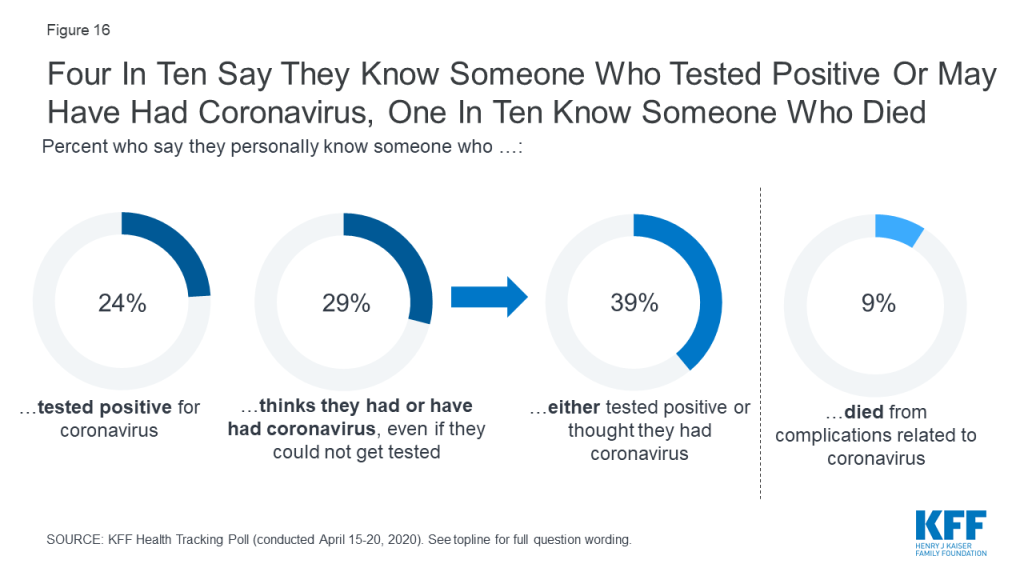
Knowing someone who has either died from complications from coronavirus, tested positive, or had coronavirus does not lead to larger support for using smart phone technology for contact tracing.
| Table 3: Direct Experience With Coronavirus and Support for Contact Tracing Apps | ||
| Percent who say they would be willing to download/use an app for their phone … | Know someone who tested positive/had symptoms/died of coronavirus | Do not know someone who tested positive/had symptoms/died of coronavirus |
| … that tracks who you come into close contact with and then alerts you if you have come into contact with someone who tested positive for coronavirus so that you can take steps to protect you and your family | 53% | 49% |
| .. that tracks who you come into close contact with and then provides that information to public health officials to track the spread of coronavirus | 49 | 42 |
| … to share the results of your coronavirus test with public health officials in order for them to track the spread of the outbreak | 68 | 68 |
Economic And Mental Health Impacts
Key Findings:
- The latest KFF Health Tracking Poll finds just over half of the February workforce (35% of all adults) say they either have lost their job (26%), had hours reduced (21%), taken a pay cut (13%) or been furloughed (7%) as a result of the coronavirus outbreak. This includes three-fourths (76%) of those who were employed part-time, and about two-thirds of hourly or contract workers (68%), and workers from lower-income households (65% of those earning less than $40,000 annually).
- Four in ten (42%) of all adults say that either they or their spouse or partner experienced a job loss or a cut in salary or hours due to the coronavirus. Among this group, most say the loss of income is either a “major problem” (41%) or “minor problem” (32%) for their household. The loss of income is a bigger problem for those in lower-income households with most of those earning less than $40,000 annually (58%) saying the loss of income is a “major problem” for their household.
- Overall, three in ten adults (29%) say they have fallen behind in paying bills or had problems affording household expenses like food or health insurance coverage since February due to the coronavirus outbreak. This rises to about four in ten among younger adults ages 18-29, those with household incomes of $40,000 or less annually, and Hispanic adults. More than half (56%) of Black adults say they have had problems paying these bills in the last two months specifically because of coronavirus. Nearly half (46%) of those who had an income loss due to coronavirus say they have had difficulty paying bills or affording household expenses since the outbreak.
- Many of the potential impacts of the loss of a job have not yet been fully realized by those affected by the coronavirus outbreak. Most say they have not yet applied for unemployment benefits (69%), and that they think that they will get their previous job or salary back within six months (83%). Less than half of those who lost their job or were laid off say their former place of employment is still open for business (39%) while most say it is closed temporarily (56%). Only 2% say their former place of employment has closed permanently.
- Over half of U.S. adults (56%) report that worry or stress related to the coronavirus outbreak has caused them to experience at least one negative effect on their mental health and wellbeing, such as problems with sleeping or eating, increased alcohol use, or worsening chronic conditions. Stress and worry around the coronavirus also seems to be affecting larger shares of frontline health care workers and their families (64%) as well as those who experienced an income loss (65%).
The Economic Impact of Coronavirus on U.S. Families
Many U.S. adults say they have had difficulty paying household expenses because of the coronavirus outbreak. About one in five say they have fallen behind in paying credit card or other bills (21%), while one in seven have had problems paying their utilities (16%), fallen behind in paying their rent or mortgage (15%), or had problems paying for food (14%) as a result of the coronavirus outbreak. An additional one in ten say they have had problems affording their health coverage (7%) or their prescription medications (5%).
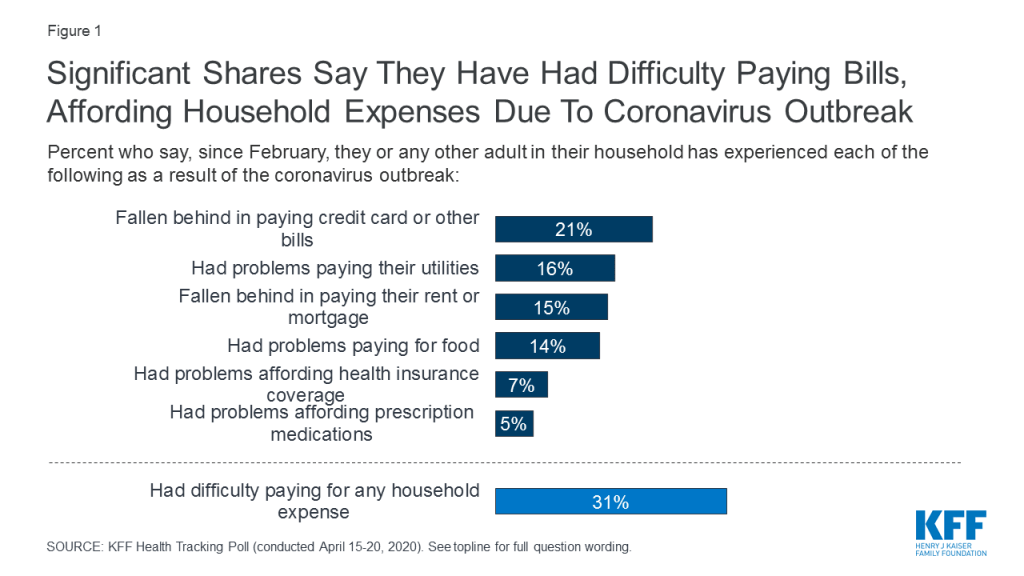
Overall, three in ten adults say they have fallen behind in paying bills or had problems affording household expenses like food or health insurance coverage since February due to the coronavirus outbreak. This rises to four in ten among younger adults (18-29), those with household incomes of $40,000 or less annually, and Hispanic adults. More than half (57%) of Black adults say they have had problems paying these bills in the last two months.

Prior to the outbreak of coronavirus and the closing of non-essential businesses across the U.S., the February 2020 KFF Health Tracking Poll found about half of adults (52%) said they could pay a $500 unexpected bill in full at the time of service. Now, 2 months later, the share who say they could pay this bill in full at time of service is down 6 percentage points to 46%, with one in five (21%) now saying they would not be able to pay the bill at all and 28% saying they would put it on a credit card and pay it off over time or borrow money to cover the costs. Additionally, the share who say they wouldn’t be able to pay the bill at all has increased 6 percentage points over the past two months.
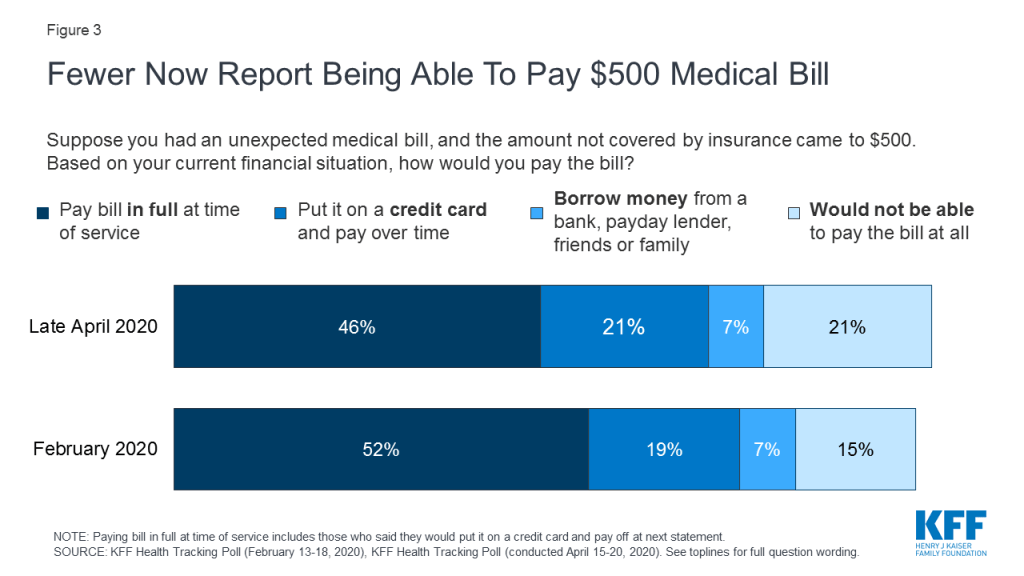
Large Shares Report Loss of Job or Wages
The U.S. Labor Department reported on April 23rd that more than 26 million Americans have filed unemployment claims in the past four weeks, marking the greatest increase in unemployment in this century.1 The latest KFF Health Tracking Poll finds just over half (55%) adults who were employed as of February 1, 2020 (63% of total) say they either have lost their job (26%), had hours reduced (21%), taken a pay cut (13%) or been furloughed (7%) as a result of the coronavirus outbreak. This equates to more than one-third (35%) of all U.S. adults who say they have lost their jobs or had a reduction in hours or pay as a result of the coronavirus outbreak.
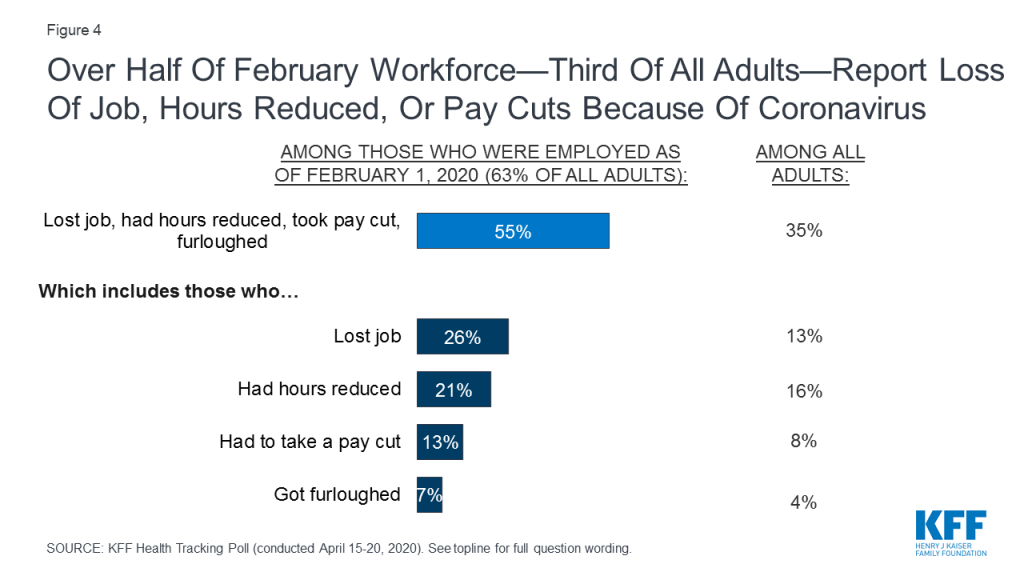
Three-fourths (76%) of those who were employed part-time as of February 1st report either having their hours reduced, a pay cut, or a job loss because of the coronavirus outbreak, compared to 52% of those were employed full-time. Twice as many hourly or contract workers report loss of a job or income related to coronavirus compared to salaried workers (68% vs. 30%). Workers from lower-income households are also more likely to report having an employment-related loss due to coronavirus compared to households earning $90,000 or more annually.
| Table 1: Many Of Those Who Were Employed As February 1 Now Report Employment-Related Loss Related To Coronavirus | |||||||||
| Total EmployedAs Of Feb. 1(66% of all adults) | Hours | Compensation | Household income | ||||||
| Full-time | Part-time | Salary | Hourly/By the job | <$40K | $40 to <$90K | $90K+ | |||
| Percent who say they … | |||||||||
| Had hours reduced | 21% | 20% | 26% | 13% | 25% | 23% | 23% | 17% | |
| Lost job | 26 | 23 | 41 | 9 | 34 | 31 | 30 | 13 | |
| Had to take a pay cut | 13 | 13 | 15 | 9 | 15 | 13 | 14 | 14 | |
| Been placed on furloughed | 7 | 6 | 8 | 3 | 8 | 10 | 5 | 3 | |
| Any of the above | 55 | 52 | 76 | 30 | 68 | 65 | 62 | 38 | |
| NOTE: Individuals could say yes to both taken a pay cut or had hours reduced. | |||||||||
In addition to those who personally experienced a coronavirus-related job or income loss, 16% say they have a spouse or partner who has lost their job, had hours reduced, took pay cut, or been furloughed. In total, 42% of all U.S. adults say they or their spouse or partner has had their income or employment impacted by the coronavirus outbreak.2
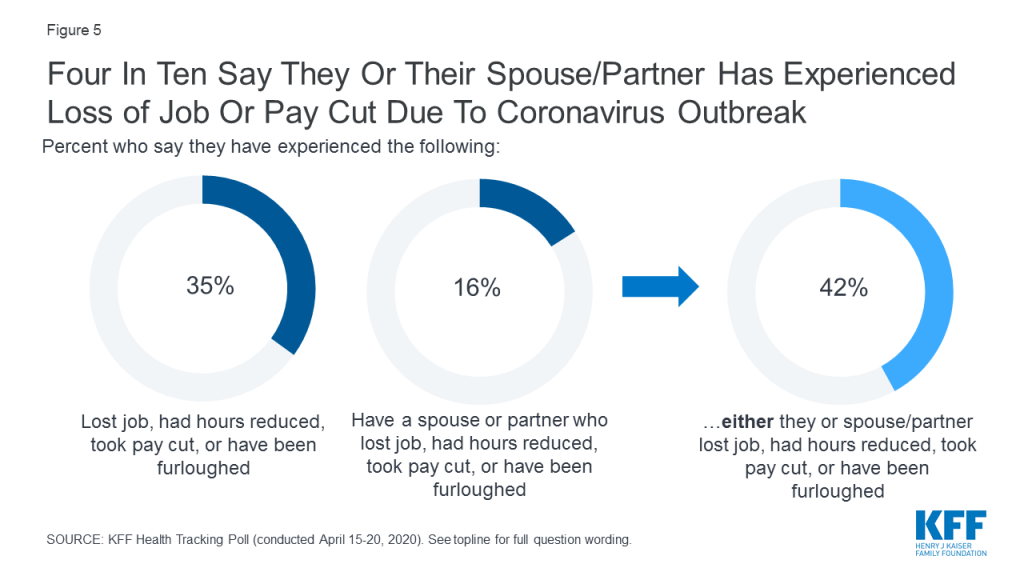
At least four in ten across most demographic groups, including more than half of Hispanic adults (56%), between the ages of 30 and 49 (53%), and those with household incomes between $40,000 and $89,999 (51%), report that either they or their spouse/partner have either lost their job, had hours reduced, took a pay cut, or have been furloughed as a result of the coronavirus outbreak. A smaller share of older adults, 65 and older, report a loss of employment-related income (18%).
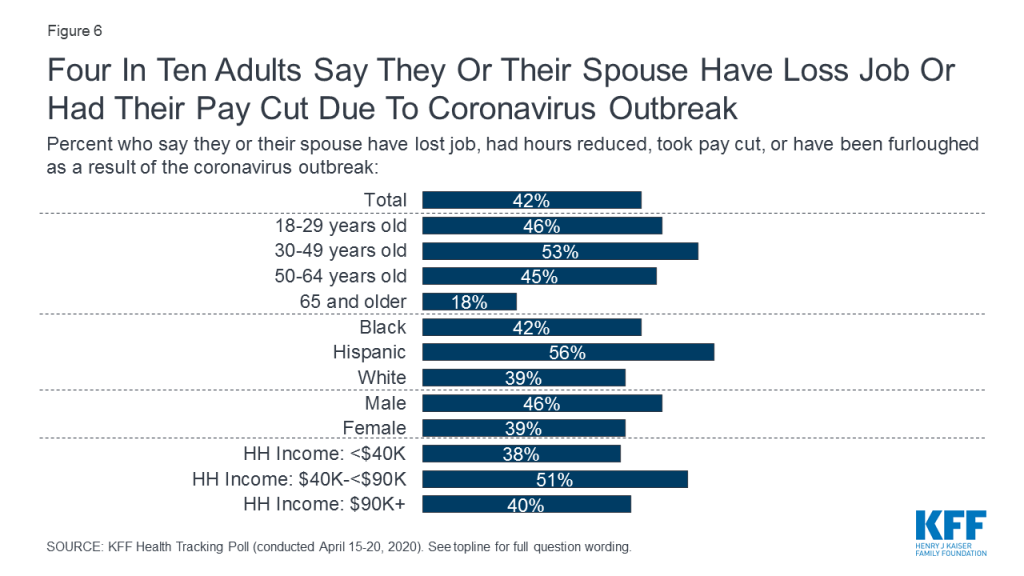
Three in four (74%) of those who have experienced a loss of income (either themselves or a spouse) say it is a problem for their household including four in ten (41%) who say the loss of income is a “major problem” for their household. An additional one-third (32%) say the loss of income is a “minor problem.” About one-fourth say the loss of income is “not a problem” for their household.
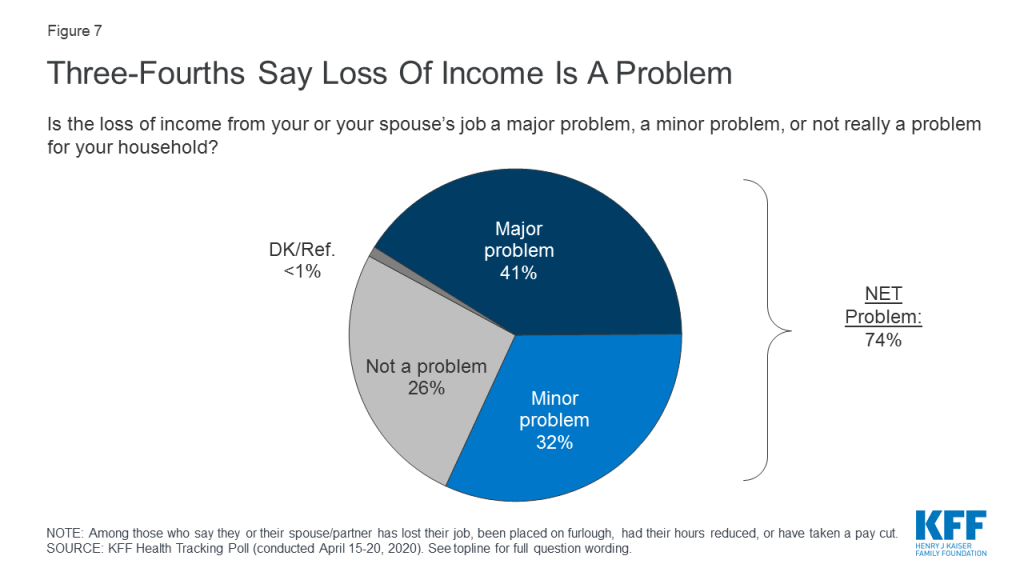
The loss of employment is a major problem for the lowest income households (less than $40,000 annual income), but a significant share of those living in households earning $40,000 to $89,999 also report the loss of income will be a problem for their household. Among those who say their household experienced a loss of job or income, six in ten (58%) of those earning less than $40,000 annually say the loss of income is a “major problem,” as do 39% of those earning between $40,000 and $89,999.
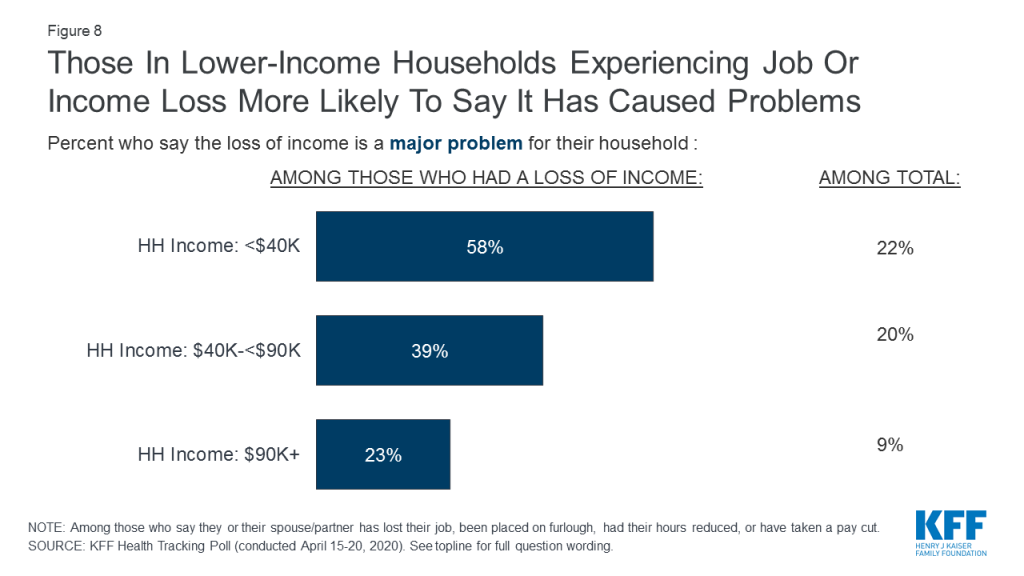
Nearly half (46%) of those who had an income loss due to coronavirus say they have had difficulty paying bills or affording household expenses since the outbreak (compared to three in ten among the public overall).
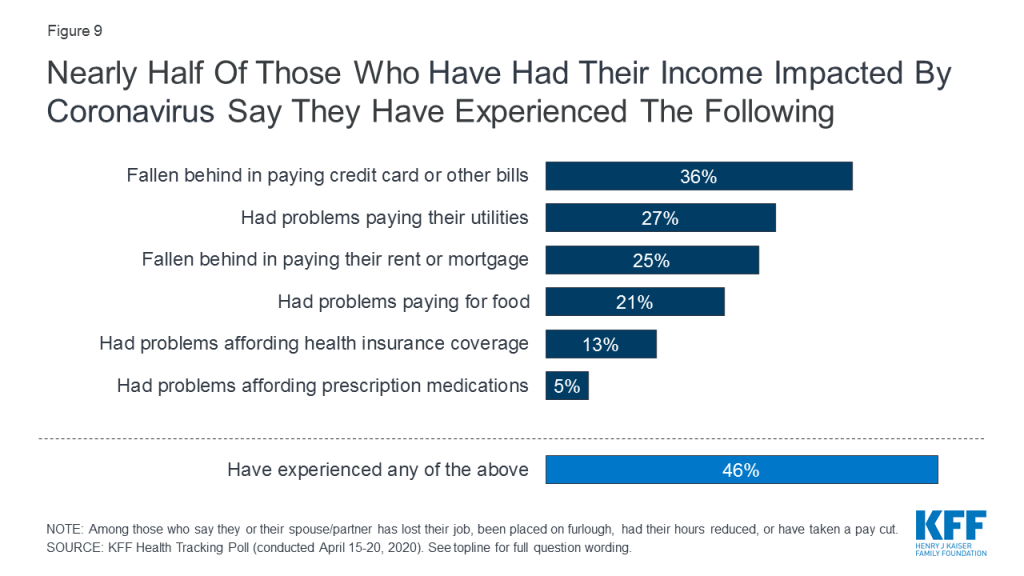
Most Who Have Experienced Employment Loss Say They Expect To Get Their Jobs Back
Among those who had lost their job or had their pay reduced as a result of the coronavirus (35% of the total population), eight in ten (83%) say they expect to be either hired back, get their previous salary or hours back in the next six months. This includes 86% of those who had a job loss or were furloughed who say they expect to be hired back and 81% of those who had a pay cut or their hours reduced who say they expect to get their previous salary or hours back in the next six months.
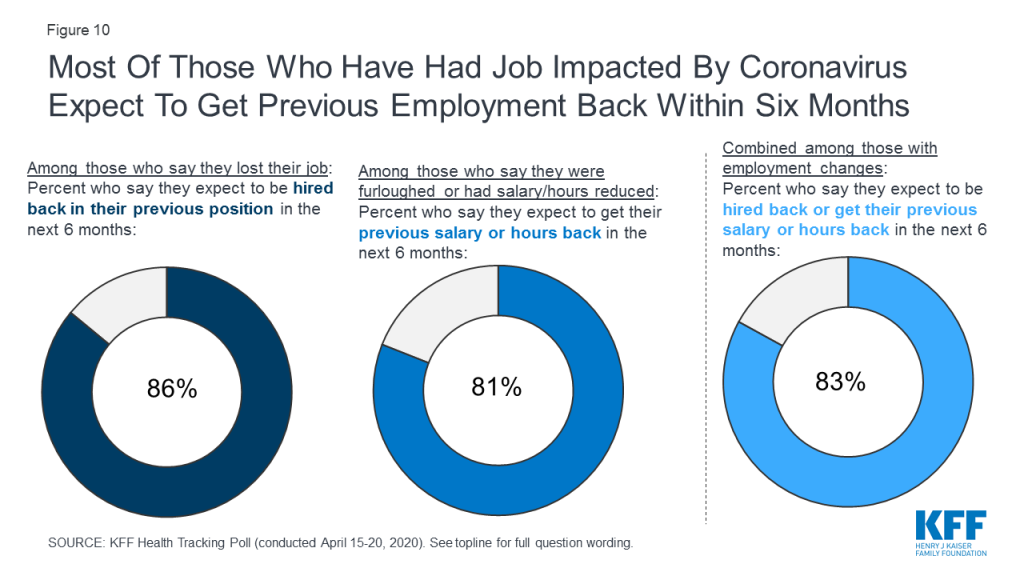
Less than half of those who lost their job or were laid off say their former place of employment is still open for business (39%) while most say it is closed temporarily (56%). Only 2% say their former place of employment has closed permanently.
The Uncertain Future
There are significant disagreements among policymakers and public health officials on when the U.S. economy will open back up. Some states are re-opening non-essential businesses in the coming weeks while other states warn it may be weeks or months until shelter-in-place restrictions are loosened and businesses can open up. The latest KFF Health Tracking Poll finds many Americans have already experienced an impact on either their own employment or their household income due to coronavirus. But it is also clear that many are unsure of how long this may last. About half of those who lost their job entirely say they have applied for unemployment benefits but smaller shares of those who have either been furloughed or had salary or hours reduced say the same. Additionally, only four in ten (37%) of households earning less than $40,000 annually say they have applied for these benefits. And while only 2% of those who lost their job know their businesses is closed permanently, it is unclear on what share of businesses will be able to re-open and re-hire their former employees in the next six months.
The Impacts of Coronavirus on Health Insurance Coverage, Mental Health, and Wellbeing
Changes in employment status could have serious implications for access to health insurance coverage for adults in the U.S. The latest KFF Health Tracking Poll finds that among those who lost a job or had a reduction in salary or hours (either themselves or a spouse), most report no change in their health insurance status at this point.
About eight in ten of those who say they or their spouse lost a job or were laid off (77%) or had hours or income reduced (82%) say they are still currently insured. Few (9% and 2%, respectively) say they are newly insured because they lost employer-sponsored coverage or another form of coverage. It is unclear whether those who so far have remained insured in the face of job loss will be able to retain their coverage, or whether the share losing such coverage may rise over the course of the outbreak.
| Table 2: Health Insurance Coverage Among Those Who Say They Or Their Spouse/Partner Experienced A Loss Of Employment | |||
| Percent who say they are: | Self or spouse experienced any type of income or job loss (42% of total) | Self or spouse lost a job or were laid off (23% of total) | Self or spouse furloughed or had hours or income reduced (23% of total) |
| Currently insured | 79% | 77% | 82% |
| Currently uninsured (NET) | 19 | 22 | 15 |
| Newly uninsured (lost ESI or other coverage) | 6 | 9 | 2 |
| Uninsured before loss of job or income | 13 | 13 | 13 |
The Impact On mental health and wellbeing
Adults in the U.S. report that worry and stress related to the coronavirus outbreak is affecting their mental health and wellbeing in various ways. Four in ten say such worry or stress has led to problems with their sleep, while one-third say they either have had a poor appetite or have been over-eating. Some also say worry or stress related to the coronavirus outbreak has caused them to experience frequent headaches or stomachaches (18%), difficulty controlling their temper (15%), or increasing their alcohol or drug use (13%). About one in ten (9%) say coronavirus-related stress has led to worsening chronic health conditions. Over half of U.S. adults (56%) report that worry or stress related to the coronavirus outbreak has affected them in at least one of these ways.

Majorities across most demographic groups including race and ethnicity, gender, and income report that worry or stress related to coronavirus has caused adverse effects on their mental health or wellbeing in the past two months. To see more on the implications of COVID-19 for mental health, see this KFF analysis.
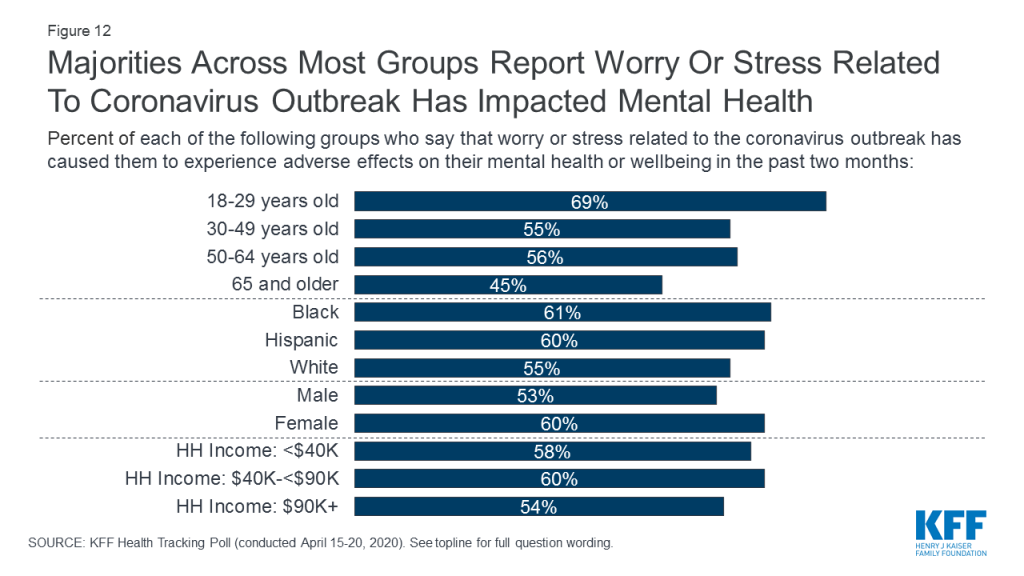
The coronavirus outbreak’s impact on mental health and wellbeing also seems to be affecting large shares of frontline health care workers and their families, as well as those who experienced a loss of employment income. About two-thirds of those living in a household with a health care worker (64%) and a similar share of those who have lost their job or income (65%) say that worry or stress related to the coronavirus outbreak has caused them to experience at least one adverse effect on their mental health or wellbeing in the past two months.
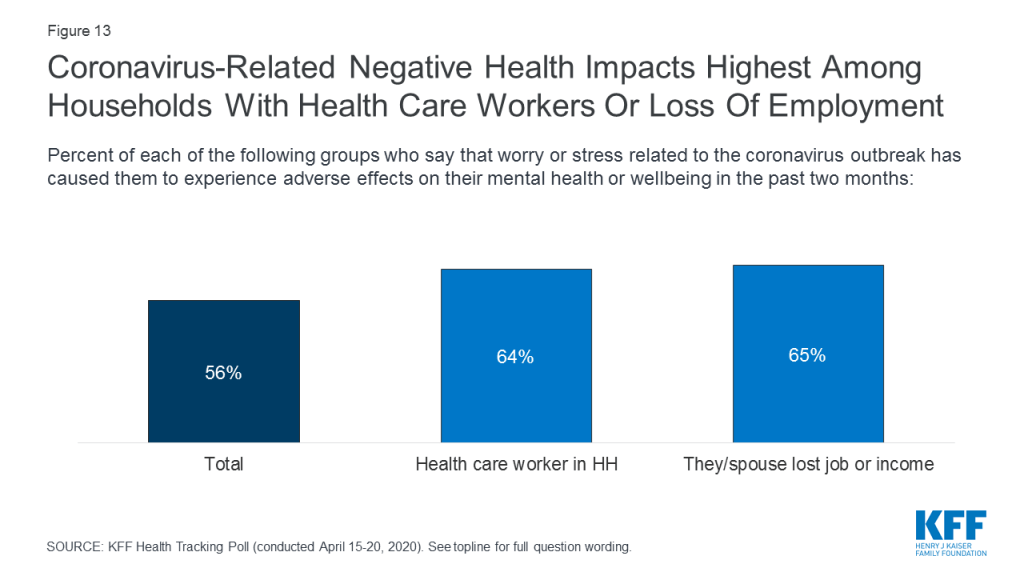
Since the coronavirus outbreak one in five (19%) say they have needed but been unable to get some type of medical care or prescription medications. This includes 16% who say they were unable to get medical care for conditions or concerns unrelated to coronavirus, 4% who say they were unable to get prescription medications, and 3% who say they were unable to get needed mental health services.
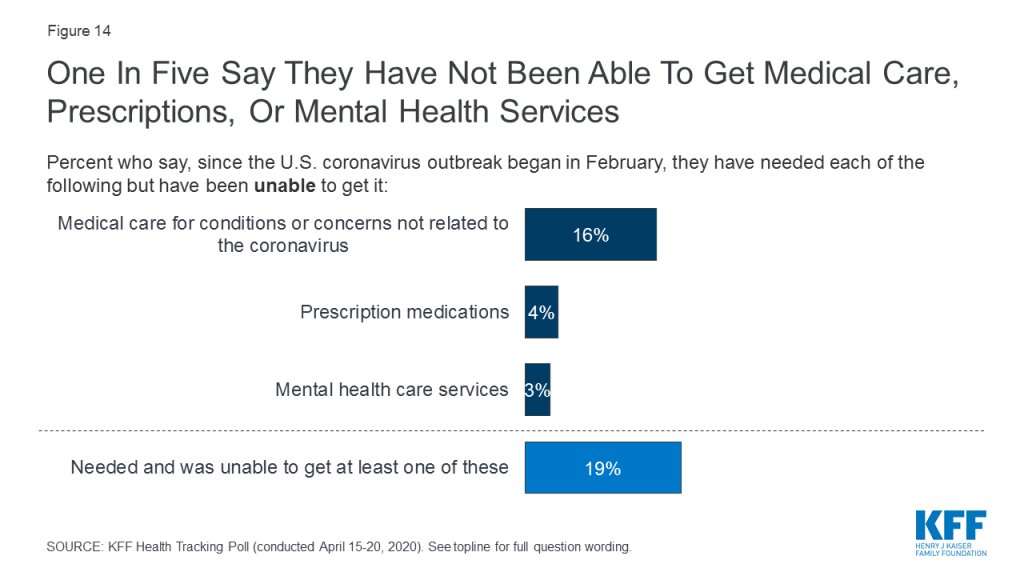
Endnotes
1 – “Jobless claims: Another 4.427 million Americans file for unemployment beenfits.” Yahoo! Finance (April 23, 2020). https://finance.yahoo.com/news/coronavirus-covid-weekly-initial-jobless-claims-april-18-165759755.html
2 – This is consistent with the KFF Early April Health Tracking Poll that found four in ten (39%) adults reporting they had already either lost their job, lost income, or had their hours reduced without pay because of the coronavirus outbreak.
Methodology
This KFF Health Tracking Poll was designed and analyzed by public opinion researchers at the Kaiser Family Foundation (KFF). The survey was conducted April 15th – 20th, 2020, among a nationally representative random digit dial telephone sample of 1,202 adults ages 18 and older, living in the United States, including Alaska and Hawaii (note: persons without a telephone could not be included in the random selection process). The sample included 290 respondents reached by calling back respondents that had previously completed an interview on the KFF Tracking poll at least nine months ago. Computer-assisted telephone interviews conducted by landline (261) and cell phone (941, including 661 who had no landline telephone) were carried out in English and Spanish by SSRS of Glen Mills, PA. To efficiently obtain a sample of lower-income and non-White respondents, the sample also included an oversample of prepaid (pay-as-you-go) telephone numbers (25% of the cell phone sample consisted of prepaid numbers) as well as a subsample of respondents who had previously completed Spanish language interviews on the SSRS Omnibus poll (n=10). Both the random digit dial landline and cell phone samples were provided by Marketing Systems Group (MSG). For the landline sample, respondents were selected by asking for the youngest adult male or female currently at home based on a random rotation. If no one of that gender was available, interviewers asked to speak with the youngest adult of the opposite gender. For the cell phone sample, interviews were conducted with the adult who answered the phone. KFF paid for all costs associated with the survey.
The combined landline and cell phone sample was weighted to balance the sample demographics to match estimates for the national population using data from the Census Bureau’s 2018 American Community Survey (ACS) on sex, age, education, race, Hispanic origin, and region along with data from the 2010 Census on population density. The sample was also weighted to match current patterns of telephone use using data from the July-December 2018 National Health Interview Survey. The weight takes into account the fact that respondents with both a landline and cell phone have a higher probability of selection in the combined sample and also adjusts for the household size for the landline sample, and design modifications, namely, the oversampling of prepaid cell phones and likelihood of non-response for the re-contacted sample. All statistical tests of significance account for the effect of weighting.
The margin of sampling error including the design effect for the full sample is plus or minus 3 percentage points. Numbers of respondents and margins of sampling error for key subgroups are shown in the table below. For results based on other subgroups, the margin of sampling error may be higher. Sample sizes and margins of sampling error for other subgroups are available by request. Note that sampling error is only one of many potential sources of error in this or any other public opinion poll. Kaiser Family Foundation public opinion and survey research is a charter member of the Transparency Initiative of the American Association for Public Opinion Research.
| Group | N (unweighted) | M.O.S.E. |
| Total | 1,202 | ± 3 percentage points |
| Party Identification | ||
| Democrats | 348 | ± 6 percentage points |
| Republicans | 341 | ± 6 percentage points |
| Independents | 347 | ± 6 percentage points |
| Age | ||
| 18-39 | 314 | ± 6 percentage points |
| 40-59 | 384 | ± 6 percentage points |
| 60-74 | 353 | ± 6 percentage points |
| 75 and older | 132 | ±10 percentage points |
| 60 and older | 485 | ±5 percentage points |
Endnotes
- Counties were classified by their confirmed number of coronavirus deaths as of April 17, 2020. Data for deaths attributed to coronavirus by county were taken from the Coronavirus (Covid-19) Data in the United States repository maintained by the New York Times (downloaded on April 18th). ↩︎
- “Trump says states can start reopening” (April 16, 2020) The New York Times. https://www.nytimes.com/2020/04/16/us/politics/coronavirus-trump-guidelines.html ↩︎
- Centers for Disease Control and Prevention, Coronavirus Disease 2019, Contact Tracing. https://www.cdc.gov/coronavirus/2019-ncov/php/open-america/contact-tracing.html ↩︎